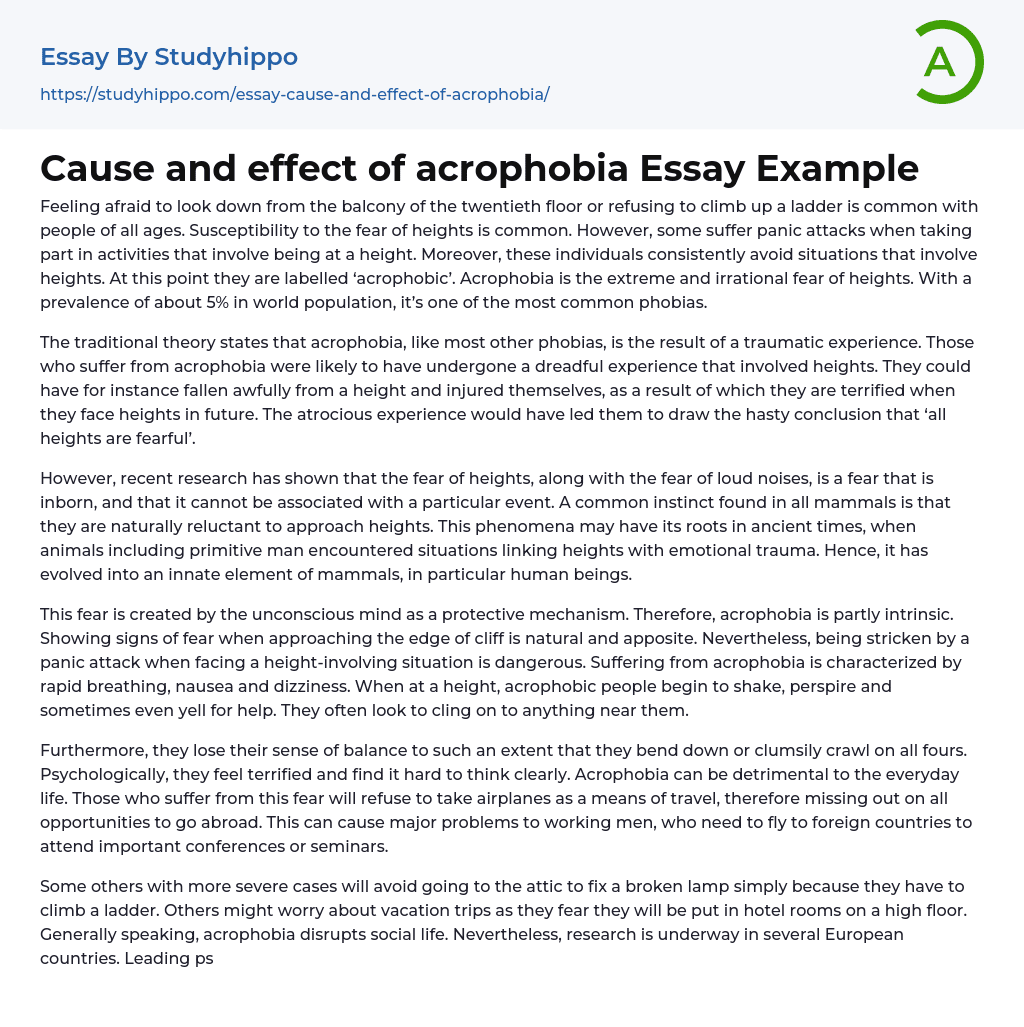Feeling afraid to look down from the balcony of the twentieth floor or refusing to climb up a ladder is common with people of all ages. Susceptibility to the fear of heights is common. However, some suffer panic attacks when taking part in activities that involve being at a height. Moreover, these individuals consistently avoid situations that involve heights. At this point they are labelled ‘acrophobic’. Acrophobia is the extreme and irrational fear of heights. With a prevalence of about 5% in world population, it’s one of the most common phobias.
The traditional theory states that acrophobia, like most other phobias, is the result of a traumatic experience. Those who suffer from acrophobia were likely to have undergone a dreadful experience that involved heights. They could have for instance fallen awfully from a height and
...injured themselves, as a result of which they are terrified when they face heights in future. The atrocious experience would have led them to draw the hasty conclusion that ‘all heights are fearful’.
However, recent research has shown that the fear of heights, along with the fear of loud noises, is a fear that is inborn, and that it cannot be associated with a particular event. A common instinct found in all mammals is that they are naturally reluctant to approach heights. This phenomena may have its roots in ancient times, when animals including primitive man encountered situations linking heights with emotional trauma. Hence, it has evolved into an innate element of mammals, in particular human beings.
This fear is created by the unconscious mind as a protective mechanism. Therefore, acrophobia is partly intrinsic. Showin
signs of fear when approaching the edge of cliff is natural and apposite. Nevertheless, being stricken by a panic attack when facing a height-involving situation is dangerous. Suffering from acrophobia is characterized by rapid breathing, nausea and dizziness. When at a height, acrophobic people begin to shake, perspire and sometimes even yell for help. They often look to cling on to anything near them.
Furthermore, they lose their sense of balance to such an extent that they bend down or clumsily crawl on all fours. Psychologically, they feel terrified and find it hard to think clearly. Acrophobia can be detrimental to the everyday life. Those who suffer from this fear will refuse to take airplanes as a means of travel, therefore missing out on all opportunities to go abroad. This can cause major problems to working men, who need to fly to foreign countries to attend important conferences or seminars.
Some others with more severe cases will avoid going to the attic to fix a broken lamp simply because they have to climb a ladder. Others might worry about vacation trips as they fear they will be put in hotel rooms on a high floor. Generally speaking, acrophobia disrupts social life. Nevertheless, research is underway in several European countries. Leading psychologists are conducting experiments in order to find effective ways to treat acrophobia.
- Pressure essays
- Confidence essays
- Disgrace essays
- Lost essays
- Harmony essays
- Fairness essays
- Sarcasm essays
- Respect essays
- Responsibility essays
- Empathy essays
- Suffering essays
- Suspense essays
- Fear essays
- Feeling essays
- Loneliness essays
- Ambition essays
- Tolerance essays
- Hope essays
- Inspiration essays
- Kindness essays
- Shame essays
- Desire essays
- Doubt essays
- Grief essays
- Hate essays
- Laughter essays
- Passion essays
- Pride essays
- Forgiveness essays
- Happiness essays
- Humanity essays
- Loyalty essays
- Guilt essays
- Honesty essays
- Betrayal essays
- Need essays
- Boredom essays
- Courage essays
- Regret essays
- Anger essays
- Honor essays
- Honesty Is The Best Policy essays
- Abnormal Psychology essays
- Abraham Maslow essays
- Attachment Theory essays
- Authority essays
- Behaviorism essays
- Classical Conditioning essays
- Cognitive Psychology essays
- Counseling essays




